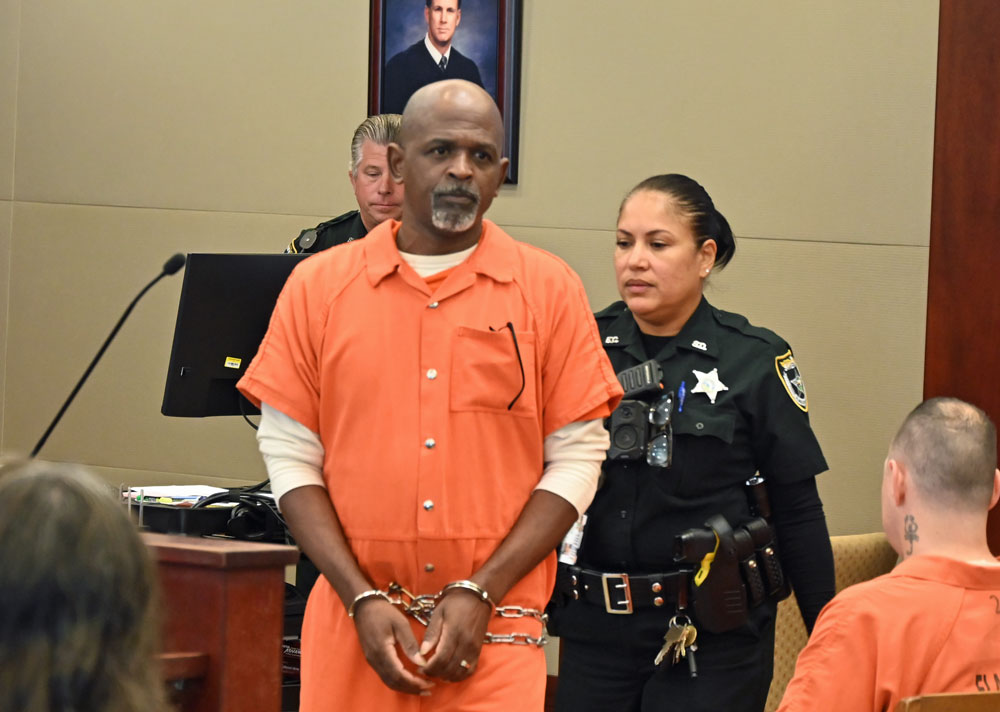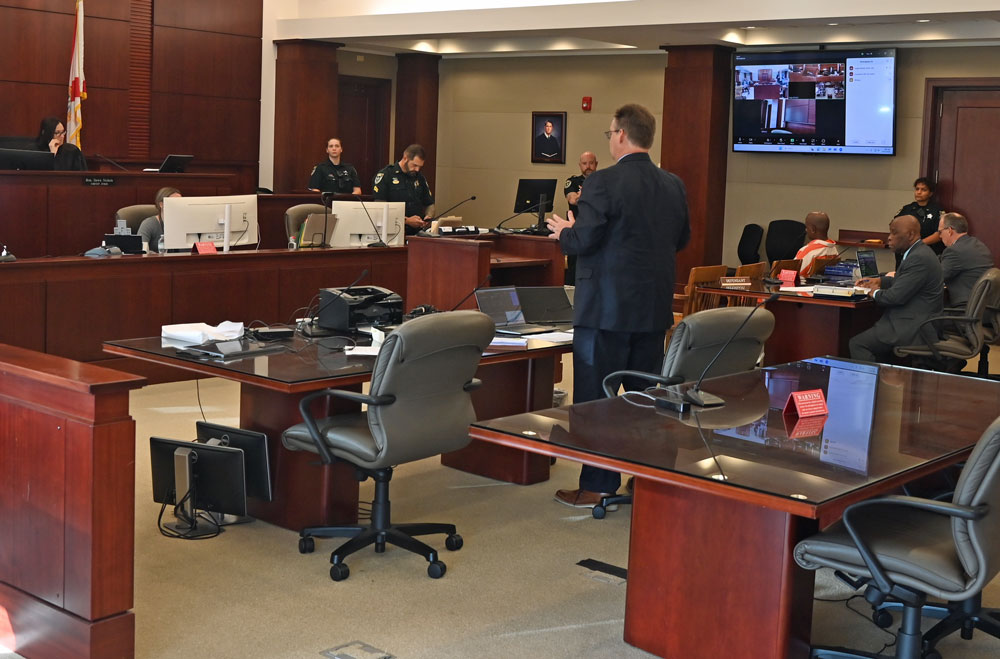
The word “granted” did not cross Circuit Judge Dawn Nichols’s lips but once today as the defense team for Jermaine Williams argued 26 motions before Williams’s death-penalty trial for the stabbing to death of his wife Yolonda Williams in the driveway of the couple’s Bunnell house 14 months ago.
The only motion the judge granted was a request to issue a questionnaire to the jury during jury selection. It’ll be a very cursory one, without touching on capital punishment. The judge denied all the others, many of them constitutional, including a challenge to the death penalty itself, to death by lethal injection,. to victim-impact statements, to Florida’s relatively new law that requires as few as eight of 12 jurors to recommend death (as opposed to the requirement for unanimity to convict), and to any evidence that could create sympathy for Yolonda.
Jermaine Williams Sr, 53, is to be tried early next year, possibly in March. Assistant State Attorney Mark Johnson is ready to try the case. Defense attorneys Junior Barrett and Anthony Leonard, both public defenders with the Office of Criminal Conflict and Civil Regional Counsel for the Fifth District of Florida, need a bit more time to prepare.
As in previous pre-trial hearings, several pews in the gallery were packed with nearly two dozen of Ylonda’s friends and family members, some of them wearing bright red shirts emblazoned with a diagonal ‘YOLONDA FOR LIFE” emblazoned in capital white letters. Previously, many had appeared in white shirts imprinted with the leafy-tree emblem of the Yolonda Williams Foundation. Today one of the people in the group wore a Domestic Abuse Council shirt (the council is in Volusia County).
The judge did not make any remarks about the shirts and welcomed the family members, as she had previously. But if precedent is an indication, the judge will instruct the group at trial not to wear clothing with any kind of message the jury could read so as not to prejudice it.
Williams sat impassively in front of the defendant’s table, in his Flagler County jail striped-orange garb, looking dead ahead in compliance with bailiffs’ orders not to look at the gallery, or looking down. One couldn’t tell whether he was interested in the proceedings.
Barrett and Leonard were not surprised by the judge’s rejection of the near-totality of their motions. They expected it. Barrett went as far as to say that the motions he was arguing weren’t even for this trial court’s benefit.
“The court is bound by what the Supreme Court says. And the motions and the argument we make today [are] really to speak to the Florida Supreme Court,” Barrett told the judge, “to preserve issues, as the Court mentioned earlier, and also to speak to the U.S. Supreme Court.” In other words, the defense’s arguments are long, very long-shot arguments predicated on the remote possibility that the conviction, or at least Williams’s death sentence, would be overturned on appeal.

The arguments implicitly conceded that the defense expects the case to be appealed–in other words, it expects to lose the trial. The prosecution will be showing the jury disturbing, explicit video of Jermaine Williams as he stabbed his wife, oblivious to her pleas and those of his father, who was across the street, and who finally pulled a gun on his son to stop.
The court reminded the defense attorneys that they were challenging settled law, and that the judge is required to follow state law and Supreme Court precedents, not make new law.
Barrett’s argument, however, is that the law is not as settled as it appeared. He made two points: First, death penalty cases are no longer treated as the extraordinary cases they should be. “Judges often say, death is different,” Barrett said. “I think we kind of got away from seeing that this is different in terms of the treatment of death penalty cases.” The list of penalties eligible for the death penalty keeps growing, and the bar enabling juries to convict on factors making an offender eligible for death keeps lowering.
Second, between changing Florida Supreme Court precedents and their echoes in the legislature, state law has not been consistent, Barrett argued. In the past decade alone, the Supreme Court ruled Florida’s death penalty scheme unconstitutional because it did not require unanimous verdicts when death was recommended. A few years later, the court reversed itself, saying the earlier ruling was in error. The court’s majority had changed, and with it its ideological orientation. It made a majority of eight out of 12 jurors the permissible threshold for a death recommendation.
“Just by that approach, it kind of takes away from the fact that death is different, that life is precious,” Barrett argued, “because each time that we’re changing the required number of jurors for someone to be put to death, the facts and circumstances over what qualifies as a death case has not changed. The only thing that’s changed in terms of death cases is the increase in the number of situations where someone can die.”
The defense wanted Williams to appear in court unshackled–not just at trial, but in all pre-trial proceedings. The U.S. Supreme Court ruled unconstitutional the appearance in jail garb or in shackles of defendants at their trials. But it did not rule against concealed shackles, or the shackling and jail attire at pre-trials. Nichols was not about to contravene local rules enforced by the Flagler County Sheriff’s Office: all inmates in felony court appear shackled and in jail garb at pre-trials, and all inmates at trial on felony charges, while granted the right to appear in civilian clothes, wear invisible restraints, particularly a device that prevents them from running. Defendants out on bond are not restrained. Williams is being held without bond.
A defendant typically has difficulty walking normally when wearing the restraint. For those who wish to testify, judges typically allow the defendant to walk to and from the witness stand out of view of the jury.
“He’s not going to have any visible shackles on. I’ll leave it at that,” the judge told the defense today, making it clear that Williams will wear restraints.
Johnson, the prosecutor, went through the defense motions to refute them one by one with citations in law, which the judge wrote down in preparation for a written order addressing the lot. There was a pointed discussion about the victim-impact statements, which the U.S. Supreme Court–in a remarkable departure from precedent–found constitutional in a 6-3 decision in 1991.
“Until today, our capital punishment jurisprudence has required that any decision to impose the death penalty be based solely on evidence that tends to inform the jury about the character of the offense and the character of the defendant. Evidence that serves no purpose other than to appeal to the sympathies or emotions of the jurors has never been considered admissible,” Justice John Paul Stevens wrote in his dissent to that decision, giving Barrett some the arguments he presented to the court today. Barrett had also tried to have the victim-impact statements restricted to the judge’s chamber, or at least not read before the jury.
Johnson, the prosecutor, outlined how the state intends to introduce those statements: “How we typically do this is, we will limit ourselves to four victim-impact statements,” Johnson said, though the Supreme Court has allowed up to 12. “ We will meet with the victims, the family, friends, or whoever is going to make a statement and instruct them on what the guidelines are. We will ask them that they do their victim impact statements in writing, provide them to us, and then we will turn over a copy of that to the defense. If there’s something that they think is objectionable and we can agree on it, then we will edit it. If we don’t agree, then we would bring it to the court for a ruling.”
“That’s been my experience in the cases that I’ve handled, and I think that that’s that’s wise,” the judge, an experienced hand at death penalty cases, said. Her last such case was the sentencing phase of the death penalty trials for Troy Victorino and Jerone Hunter, convicted and originally sentenced to death in 2006 for breaking into a Deltona home, stabbing and beating six people and a dog to death with baseball bats in 2004. Their two co-defendants, Michael Salas and Robert Cannon, were sentenced to life in prison. Their death sentences were nullified in 2018 after the Supreme Court required unanimous jury recommendations in death penalty cases, and before the court reversed itself–an example of that unsettledness Barrett referred to today. (The jury voted 11-1 to recommend death for Hunter and 9-3 for Victorino. Nichols is sentencing them on Nov. 3.
The next status hearing in the Williams case is on Dec. 15 at 1:30 p.m.




























Leave a Reply